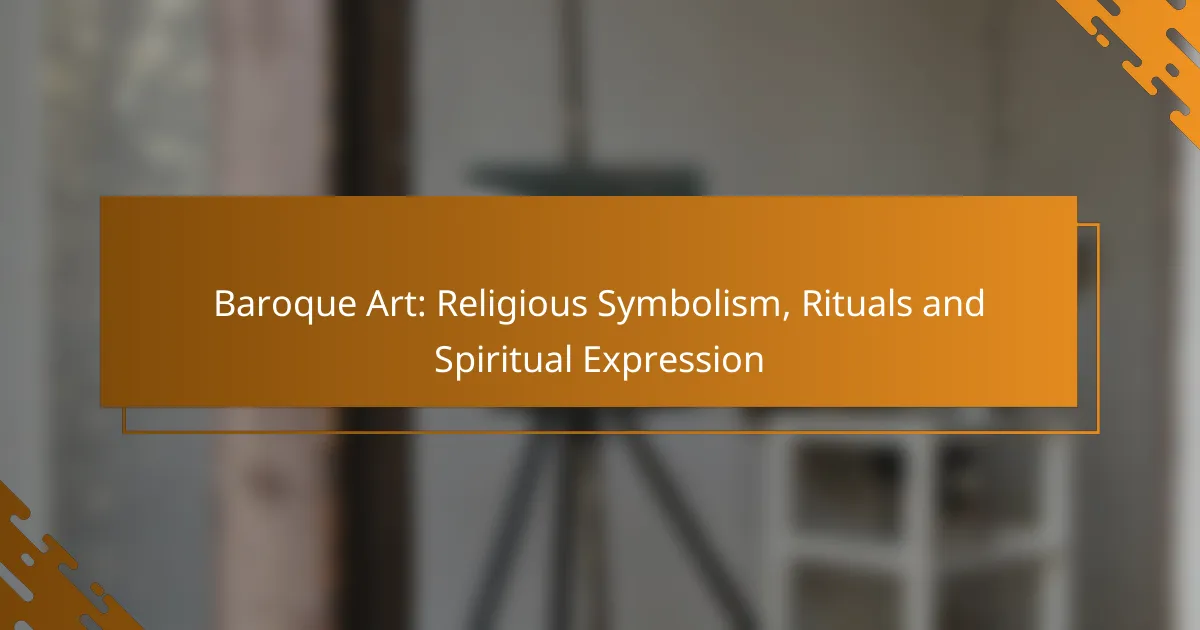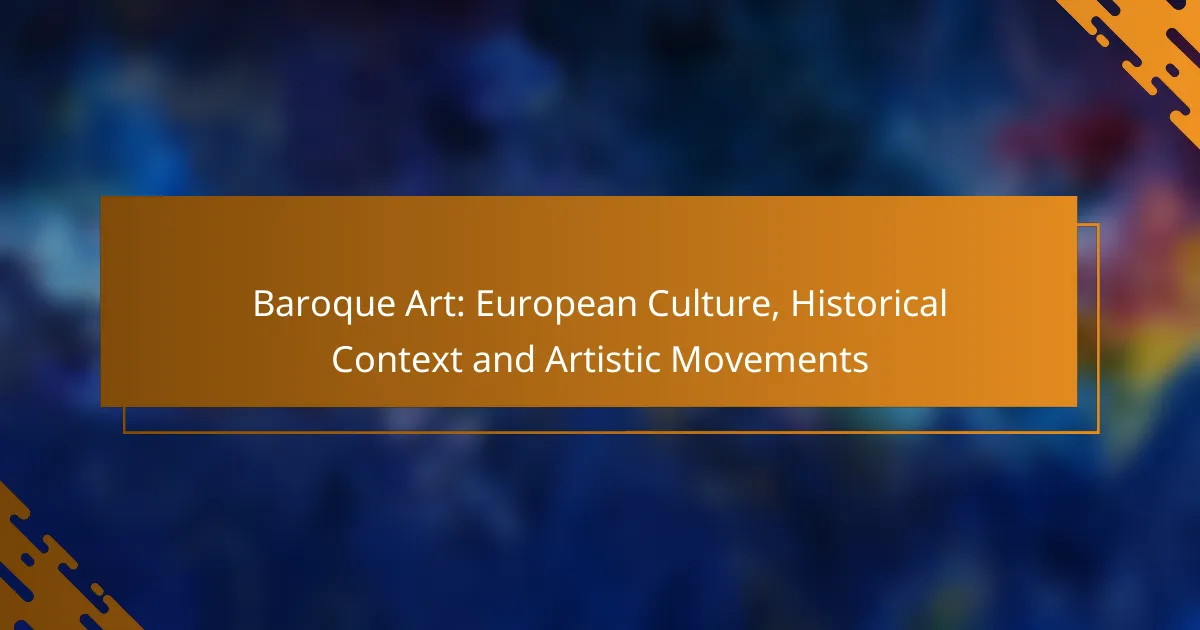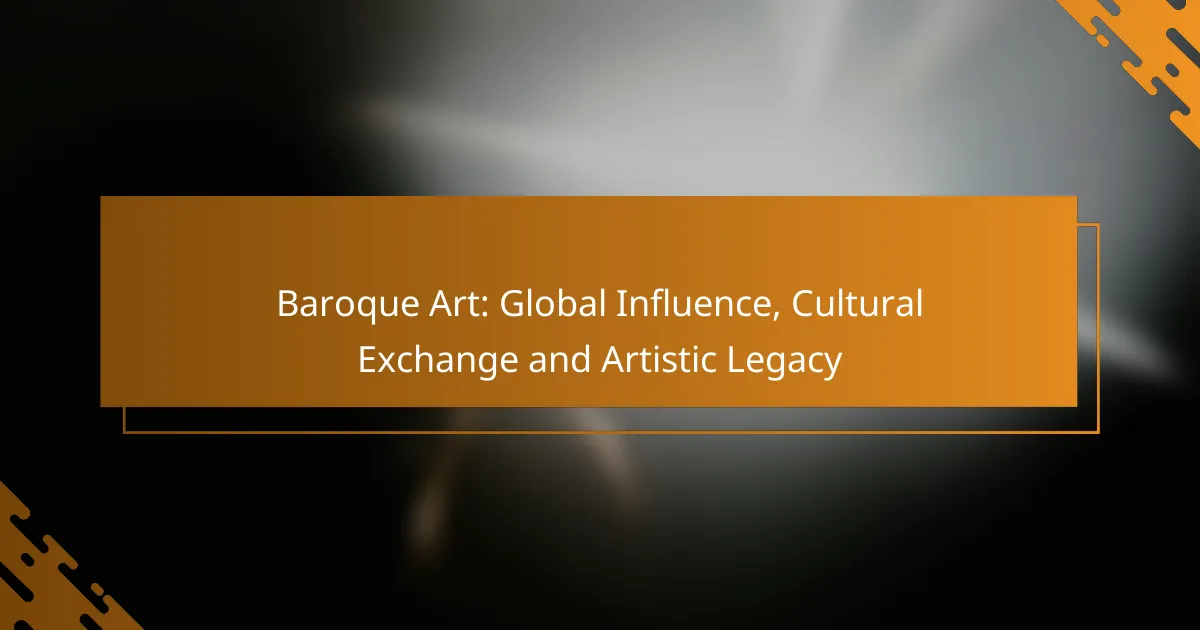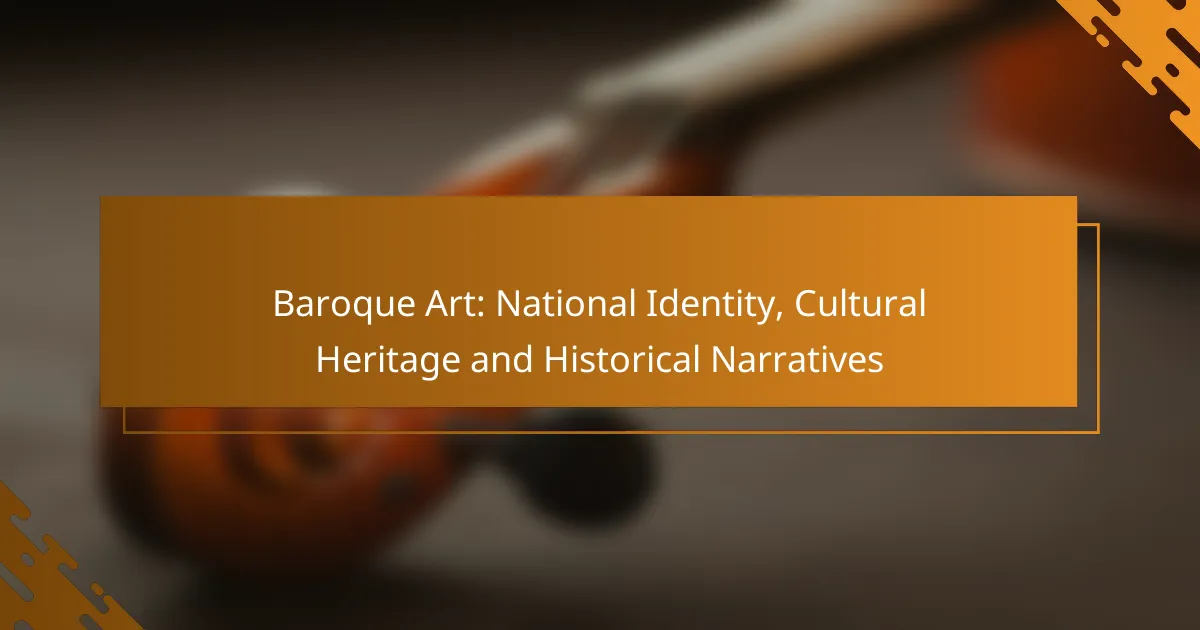Baroque Art is characterized by its profound religious symbolism and emotional depth, designed to evoke a spiritual experience in viewers. Through dramatic visuals and innovative techniques, artists captured the grandeur of rituals and the essence of personal devotion, forging a deep connection between faith and artistic expression during this vibrant period.
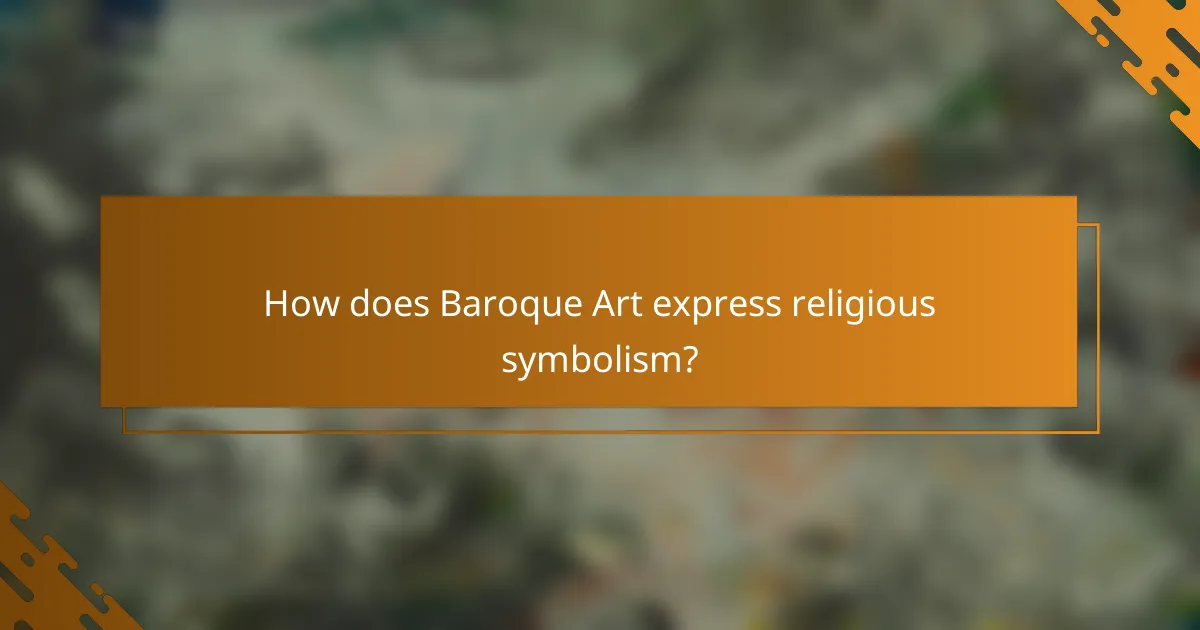
How does Baroque Art express religious symbolism?
Baroque Art expresses religious symbolism through dramatic visuals and emotional depth, aiming to evoke a spiritual experience. Artists employed various techniques to convey divine themes and narratives, making the viewer feel a connection to the sacred.
Use of light and shadow
The use of light and shadow, known as chiaroscuro, is a hallmark of Baroque Art that enhances religious symbolism. Artists like Caravaggio utilized stark contrasts to draw attention to key figures and moments, creating a sense of drama and divine presence.
This technique not only highlights the spiritual themes but also evokes emotional responses, guiding the viewer’s focus and enhancing the narrative’s impact.
Iconography in paintings
Iconography in Baroque paintings is rich with religious symbols that convey deeper meanings. Common elements include halos, crosses, and specific saints, each representing different aspects of faith and devotion.
For example, the depiction of the Virgin Mary often includes lilies, symbolizing purity, while the inclusion of angels signifies divine intervention. Understanding these symbols can enhance appreciation of the artwork’s spiritual message.
Sculptural representations
Sculptural representations in Baroque Art often depict biblical figures in dynamic poses, emphasizing movement and emotion. Artists like Gian Lorenzo Bernini created works that invite viewers to engage with the narrative, such as the dramatic expression of Saint Teresa in ecstasy.
These sculptures are designed to evoke a sense of awe and reverence, often placed in churches to enhance the spiritual atmosphere and draw worshippers into contemplation.
Architectural elements
Architectural elements in Baroque churches are designed to inspire and elevate the spiritual experience. Grand facades, soaring ceilings, and intricate altars create a sense of grandeur that reflects the glory of the divine.
For instance, the use of domes and expansive spaces allows natural light to flood the interior, symbolizing the presence of God and encouraging a connection between the earthly and the heavenly.
Emotional engagement
Emotional engagement is central to Baroque Art’s expression of religious symbolism. Artists aimed to evoke feelings of devotion, fear, or awe through their works, making the viewer a participant in the spiritual narrative.
By portraying intense emotions and dramatic scenes, Baroque artists sought to create a visceral experience that would lead to personal reflection and a deeper understanding of faith.
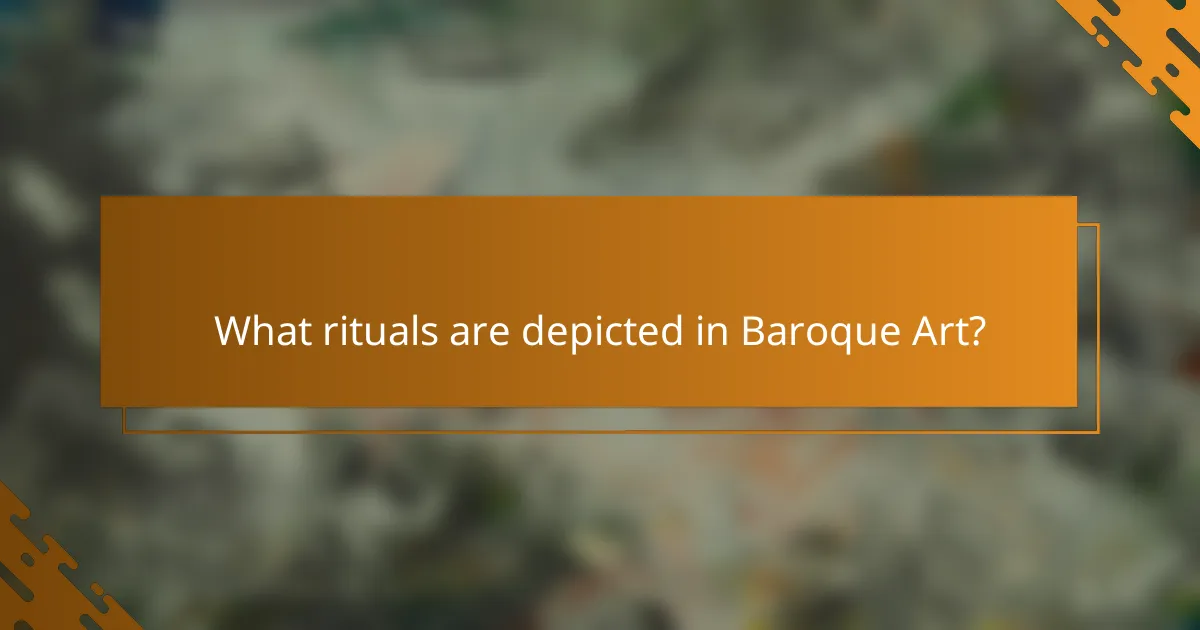
What rituals are depicted in Baroque Art?
Baroque art vividly captures various rituals, emphasizing their emotional and spiritual significance. These artworks often illustrate the grandeur of religious ceremonies, saint veneration, and community celebrations, reflecting the deep connection between faith and artistic expression during the Baroque period.
Mass and liturgical ceremonies
Mass and liturgical ceremonies are central themes in Baroque art, showcasing the solemnity and grandeur of worship. Artists often depicted the Eucharist, with dramatic lighting and rich colors to highlight the sacredness of the moment. These artworks served not only as visual aids for the faithful but also as expressions of the Church’s power and influence.
Common elements in these depictions include altars adorned with elaborate decorations, priests in ornate vestments, and congregations engaged in prayer. Such scenes aimed to evoke a sense of reverence and draw viewers into the spiritual experience of the Mass.
Saint veneration practices
Saint veneration practices are prominently featured in Baroque art, illustrating the importance of saints as intercessors in the lives of the faithful. Artists often portrayed saints in moments of divine intervention or miraculous events, emphasizing their role in guiding and protecting believers. These representations were designed to inspire devotion and encourage the faithful to seek the saints’ intercession.
Common motifs include saints depicted with their attributes, such as St. Francis with animals or St. Sebastian with arrows, which serve to identify them and convey their stories. The emotional expressions and dynamic compositions in these artworks invite viewers to connect personally with the saints.
Processions and festivals
Processions and festivals are vibrant aspects of Baroque religious life, often depicted in art to celebrate significant events in the Church calendar. These gatherings involved elaborate rituals, music, and community participation, reflecting the joy and communal spirit of faith. Artists captured the festive atmosphere, showcasing the colorful attire of participants and the grandeur of the settings.
In these artworks, one can see the use of dramatic perspectives and lively compositions that convey movement and excitement. Such depictions not only document cultural practices but also serve to reinforce community bonds and shared beliefs among the faithful.

How does Baroque Art reflect spiritual expression?
Baroque art reflects spiritual expression through its dramatic use of light, intense emotionalism, and themes of personal devotion. This artistic style emphasizes the connection between the divine and the viewer, often invoking a sense of awe and reverence.
Intense emotionalism
Intense emotionalism in Baroque art is characterized by vivid colors, dynamic compositions, and expressive figures. Artists aimed to evoke strong feelings in the viewer, often portraying moments of divine intervention or personal crisis. For example, Caravaggio’s use of chiaroscuro highlights the emotional turmoil of his subjects, drawing the audience into their spiritual experiences.
This emotional depth serves to engage the viewer on a personal level, making the spiritual themes more relatable. The dramatic contrasts of light and shadow not only enhance the visual impact but also symbolize the struggle between faith and doubt.
Personal devotion themes
Personal devotion themes in Baroque art often center around the individual’s relationship with the divine. Many works depict saints, martyrs, and biblical figures in moments of prayer or contemplation, emphasizing personal faith. For instance, paintings of the Virgin Mary frequently illustrate her maternal connection to humanity, inviting viewers to reflect on their own spiritual journeys.
These themes encourage a more intimate worship experience, as the art serves as a visual aid for meditation and prayer. Artists like Bernini created sculptures that invite the viewer to engage with the divine, reinforcing the importance of personal devotion in the Baroque period.
Contrasts between sacred and secular
Baroque art often explores the contrasts between sacred and secular themes, highlighting the tension between earthly life and spiritual aspirations. Many artists incorporated elements of both realms, creating works that resonate with a broader audience. For example, the blending of religious iconography with everyday scenes allows for a more accessible interpretation of spiritual concepts.
This juxtaposition encourages viewers to find the divine in their daily lives, reinforcing the idea that spirituality is not confined to religious institutions. Such contrasts can be seen in works by artists like Rubens, who often depicted mythological subjects alongside religious narratives, emphasizing the interconnectedness of all human experience.
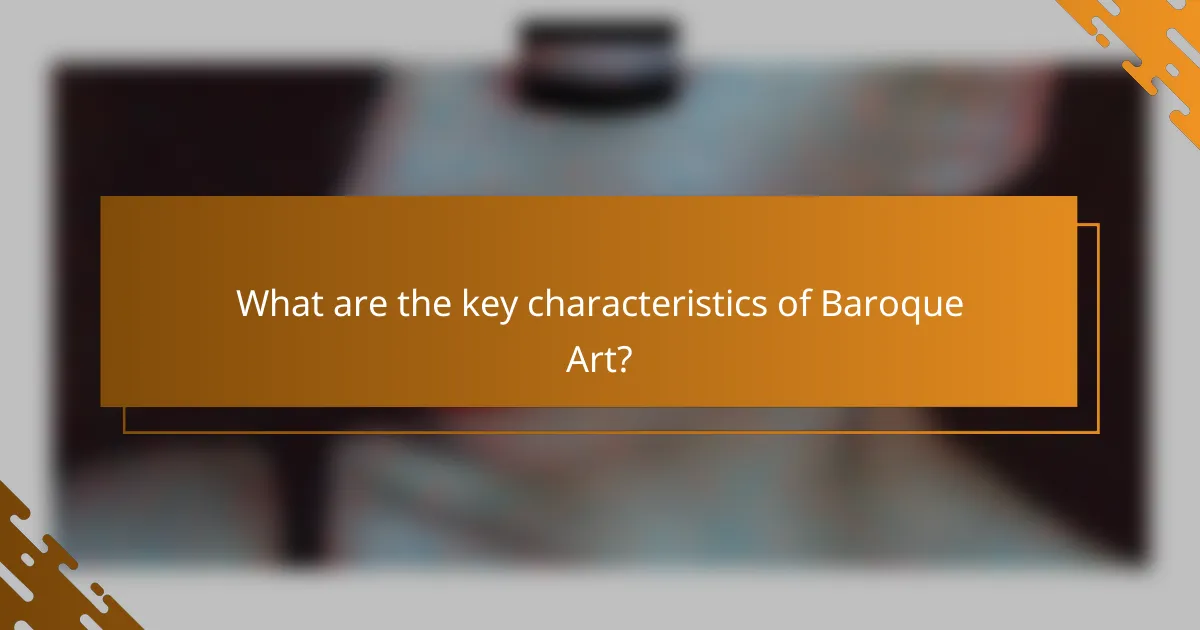
What are the key characteristics of Baroque Art?
Baroque Art is characterized by its emotional intensity, dramatic use of light and shadow, and a sense of movement. It often conveys religious themes and spiritual expression through intricate details and dynamic compositions.
Dramatic use of color
The dramatic use of color in Baroque Art enhances emotional impact and draws the viewer’s attention. Artists employed bold, contrasting colors to create a sense of depth and highlight key elements within their works.
For instance, the use of deep reds and rich golds can evoke feelings of passion and divinity, while cooler tones may suggest calmness or introspection. This strategic color application is essential for conveying the underlying messages of the artwork.
Dynamic compositions
Dynamic compositions in Baroque Art are designed to create a sense of movement and energy. Artists often arranged figures and elements in diagonal lines or circular patterns, guiding the viewer’s eye through the artwork.
This approach not only adds visual interest but also enhances the narrative quality of the piece. For example, in many religious paintings, the arrangement of figures can lead to a climactic moment, emphasizing the spiritual significance of the scene.
Realism and detail
Realism and detail are hallmarks of Baroque Art, as artists sought to depict subjects with lifelike accuracy. This attention to detail includes intricate textures, facial expressions, and naturalistic settings, which contribute to the overall emotional resonance of the work.
By focusing on realistic portrayals, Baroque artists aimed to engage viewers on a personal level, making the spiritual themes more relatable. The meticulous attention to detail often invites viewers to explore the artwork closely, revealing layers of meaning and symbolism.
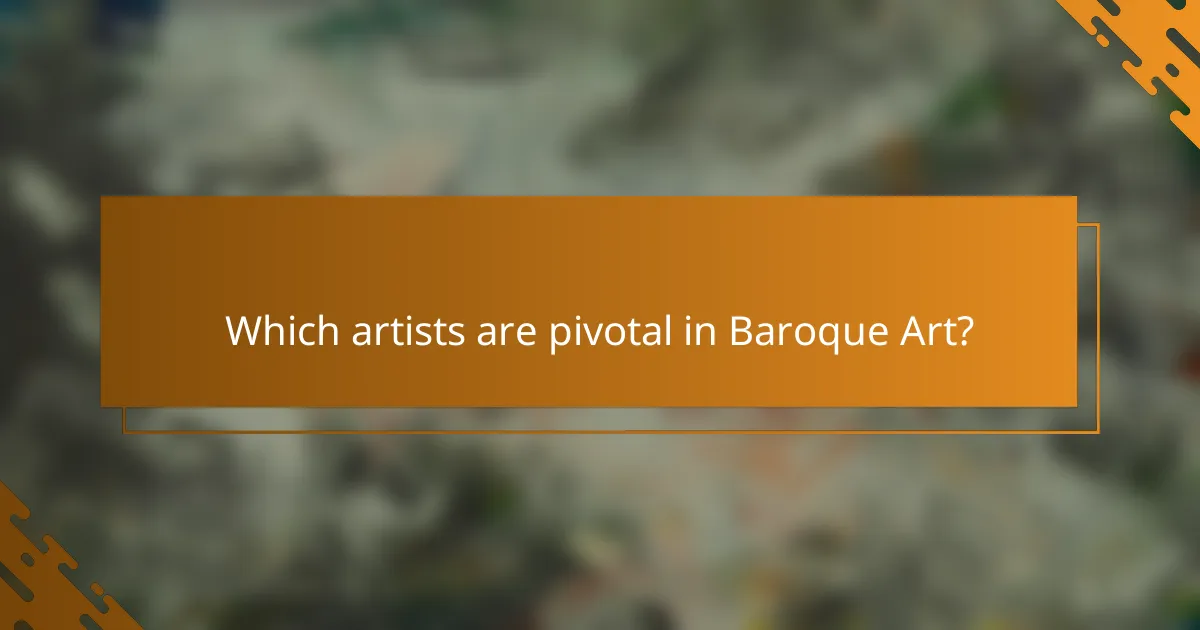
Which artists are pivotal in Baroque Art?
Key artists in Baroque Art include Caravaggio, Peter Paul Rubens, and Gian Lorenzo Bernini. Their works exemplify the dramatic expression, rich detail, and emotional intensity characteristic of the Baroque style, often focusing on religious themes and human experience.
Caravaggio’s Influence
Caravaggio is renowned for his use of chiaroscuro, the contrast between light and dark, which creates a sense of depth and drama in his paintings. His realistic portrayal of human figures and emotions brought a new level of intensity to religious scenes, making them more relatable and impactful.
Notable works such as “The Calling of Saint Matthew” and “Judith Beheading Holofernes” showcase his ability to capture raw emotion and divine moments. Caravaggio’s style influenced countless artists, leading to the emergence of the Caravaggisti, who adopted his techniques across Europe.
Peter Paul Rubens’ Mastery
Peter Paul Rubens is celebrated for his vibrant compositions and dynamic figures, often depicting themes of mythology and religion. His ability to convey movement and emotion through color and form made his works stand out during the Baroque period.
Rubens’ paintings, such as “The Elevation of the Cross” and “The Descent from the Cross,” are characterized by their grand scale and dramatic narratives. His influence extended beyond painting, impacting sculpture and decorative arts, solidifying his status as a pivotal Baroque artist.
Gian Lorenzo Bernini’s Sculpture
Gian Lorenzo Bernini is a key figure in Baroque sculpture, known for his ability to infuse marble with life and emotion. His works, such as “The Ecstasy of Saint Teresa,” exemplify the Baroque focus on spiritual experience and the dramatic interplay of light and shadow.
Bernini’s architectural contributions, including the design of St. Peter’s Basilica’s piazza, further demonstrate his versatility and impact on Baroque art. His integration of sculpture and architecture created immersive environments that enhanced the viewer’s spiritual experience.
